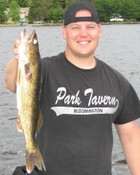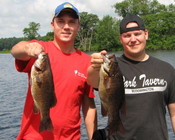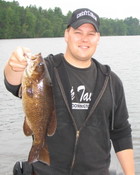 Mid-summer has arrived. The cicadas are singing, lightning bugs are in the air, passing afternoon showers are the norm, and Lake Wissota has evolved from an early season walleye factory into a mid-summer, multi-species dynamo. I was joined today by Keith and Elliot, a couple of Twin Cities anglers with family connections to our backyard gem, and the three of us enjoyed consistent and often fast multispecies action on Wissota. Persistence and versatility were the keys to our success today; persistence to wait for active fish in high-percentage locations, and versatility to move fish that we could see using our electronics from the floor of the lake into the net.
Mid-summer has arrived. The cicadas are singing, lightning bugs are in the air, passing afternoon showers are the norm, and Lake Wissota has evolved from an early season walleye factory into a mid-summer, multi-species dynamo. I was joined today by Keith and Elliot, a couple of Twin Cities anglers with family connections to our backyard gem, and the three of us enjoyed consistent and often fast multispecies action on Wissota. Persistence and versatility were the keys to our success today; persistence to wait for active fish in high-percentage locations, and versatility to move fish that we could see using our electronics from the floor of the lake into the net.
 Before we talk about walleyes, let me write a few words about Wissota’s smallmouth bass. July is when my primary smallmouth pattern sets up….finesse jigging in and around the rocks high up in the Chippewa River that feeds the lake. I’ve been waiting (impatiently) for this pattern to establish itself over the past couple of weeks, and was thrilled to find it firmly in place today. Keith, Elliot and I pulled into our first spot, a shallow current swept rocky flat at 8:15 this morning and stayed busy there until nearly 11. Our technique was simple….pitch and drag crawler-tipped 1/16 oz B-Fish-N tackle Precision Jigs among the boulders that litter the bottom on this flat. While our first 15-20 minutes were fishless, our persistence in combing this high percentage spot payed off. Elliot’s St. Croix rod was the first to bend, and like many big fish, this one was at first disguised as a snag. It was only when the tanker smallie broke the plane of the water that we realized that we were in store for a special kind of smallie experience. Unfortunately, that fish never made it to the net, but MANY others did. Most of our smallies were in the 15-17" class, including the pair that Keith and Elliot are holding in this pic.
Before we talk about walleyes, let me write a few words about Wissota’s smallmouth bass. July is when my primary smallmouth pattern sets up….finesse jigging in and around the rocks high up in the Chippewa River that feeds the lake. I’ve been waiting (impatiently) for this pattern to establish itself over the past couple of weeks, and was thrilled to find it firmly in place today. Keith, Elliot and I pulled into our first spot, a shallow current swept rocky flat at 8:15 this morning and stayed busy there until nearly 11. Our technique was simple….pitch and drag crawler-tipped 1/16 oz B-Fish-N tackle Precision Jigs among the boulders that litter the bottom on this flat. While our first 15-20 minutes were fishless, our persistence in combing this high percentage spot payed off. Elliot’s St. Croix rod was the first to bend, and like many big fish, this one was at first disguised as a snag. It was only when the tanker smallie broke the plane of the water that we realized that we were in store for a special kind of smallie experience. Unfortunately, that fish never made it to the net, but MANY others did. Most of our smallies were in the 15-17" class, including the pair that Keith and Elliot are holding in this pic.
While we did stick 3 slot walleyes mixed in with the smallies, it was the bronze bombers that ruled the roost in the river today. The primary forage for most of these river fish at this time of year is crayfish; claws and tails were being spit up constantly as hooked smallies approached the boat. To successfully target these crayfish-fed smallies, it is imporant to present your bait in a crayfish-like manner….drag it slowly across the bottom, taking lots of brief pauses. Smallies will track the bait down and pick it up during the pause. Resist the temptations to (a) do a lot of hopping of the jig, and (b) make quick hooksets. With 2-3" of crawler hanging off the back of the hook, it’s important to give that smallie a chance to get the hook into its mouth. My guests were quick studies, and proceeded to pop smallie after smallie in the river today. From now until late September, IDO readers will be treated to lots of pics of chunky Wissota smallies that fall for this finesse jigging presentation.
 For much of late May and June, we spent most of our trips pounding Wissota walleyes by trolling a combination of long lines and leadcore on the main lake. My guests and I broke out the long rods on a couple of occasions today, and a few short passes put fish in the boat. Walleyes, a couple of smallies, channel cats, a pike, and this low-20" class flathead all ran down cranks today. As the water has dirtied in the lake, crank patterns have changed from early-season natural patterns to louder color schemes. Likewise, high-action jointed baits accounted for most of our fish today, including the 20" main lake walleye shown in the first picture. When pulling cranks in the Chip, most of our fish came from ~ 12 fow, while our main lake bites were in the 16-18 fow range. While trolling the lake, we noted large (LARGE) numbers of fish holding in this depth range, but only a few could be coaxed into whacking a crank. Conviced that these were walleyes, we put the long rods away and broke out the jigs and crawler halves again. A moment or two later, the first main lake jiggin’ eye was flopping around the bottom of the boat. Versatility, and a willingness to change from one presentation to another on the fly, kept us busy with main lake walleyes as our day drew to a close.
For much of late May and June, we spent most of our trips pounding Wissota walleyes by trolling a combination of long lines and leadcore on the main lake. My guests and I broke out the long rods on a couple of occasions today, and a few short passes put fish in the boat. Walleyes, a couple of smallies, channel cats, a pike, and this low-20" class flathead all ran down cranks today. As the water has dirtied in the lake, crank patterns have changed from early-season natural patterns to louder color schemes. Likewise, high-action jointed baits accounted for most of our fish today, including the 20" main lake walleye shown in the first picture. When pulling cranks in the Chip, most of our fish came from ~ 12 fow, while our main lake bites were in the 16-18 fow range. While trolling the lake, we noted large (LARGE) numbers of fish holding in this depth range, but only a few could be coaxed into whacking a crank. Conviced that these were walleyes, we put the long rods away and broke out the jigs and crawler halves again. A moment or two later, the first main lake jiggin’ eye was flopping around the bottom of the boat. Versatility, and a willingness to change from one presentation to another on the fly, kept us busy with main lake walleyes as our day drew to a close.
 It’s hard for me to think of a better way to spend a mid-summer day than whacking a bunch of beautiful Wissota smallies and walleyes. As we move through the hottest part of the year, look to current-swept structure in the river and wind-blown structure on the lake to gather the most biters. Chunky smallies, like the 16+" fish shown in this last photo, will become more and more dominant as we move into August. Walleyes will remain available, but their activity windows will become smaller as the water warms. However, with so many species available on Wissota, I’m willing to give those walleyes a bit of a break (for now!). So, come on out to Lake Wissota to enjoy a bit of our mid-summer multi-species action. Hope to see you out there soon!
It’s hard for me to think of a better way to spend a mid-summer day than whacking a bunch of beautiful Wissota smallies and walleyes. As we move through the hottest part of the year, look to current-swept structure in the river and wind-blown structure on the lake to gather the most biters. Chunky smallies, like the 16+" fish shown in this last photo, will become more and more dominant as we move into August. Walleyes will remain available, but their activity windows will become smaller as the water warms. However, with so many species available on Wissota, I’m willing to give those walleyes a bit of a break (for now!). So, come on out to Lake Wissota to enjoy a bit of our mid-summer multi-species action. Hope to see you out there soon!
I’ll share one more pic from today’s trip. These fish, all slotters from the river, came during an honest triple header of 2 long lines and one leadcore line. I haven’t had a trolling fire-drill like this one for some time. Like all of our 14-18″ fish, these protected slotters posed for a quick pic and then swam away.
Elliot’s first Wissota smallie…one that did find the bottom of the net!
Pulling cranks in the afternoon sun.
Great multi-species report Jason! When you are out trolling cranks for walleyes, I see you are typically long lining. Since you are fishing some shallow structure, do you use planer boards at all to get your crankbaits away from the boat? Or do you tend to stay away from them due to the weeds and/or debris? Also, have you tried the new Lindy Shake E Blades and if so what is your opinion?
When you are out trolling cranks for walleyes, I see you are typically long lining. Since you are fishing some shallow structure, do you use planer boards at all to get your crankbaits away from the boat? Or do you tend to stay away from them due to the weeds and/or debris? Also, have you tried the new Lindy Shake E Blades and if so what is your opinion?
Thanks for the report Jason. I find all your tips useful at one time or another – except the lead core business. Though, when the wife lets me buy another rod & reel, I may come looking for a recommendation on lead core tackle and give it a try.
Brad, I’ve been long-lining more in recent weeks. I tend to not use planar boards, but rather establish a spread with a combination of long rods (St Croix wild river 10.5’s) in the front and shorter St Croix tidemasters in the middle of the boat, with a couple of “bonus” shorty leadore setups out the back.
I’ve done a little bit of spinner fishing this summer, and have been working the Lindy Shake-e blades into the mix. They have a very aggressive action that is much more crankbait-like than a standard spinner. For some reason this summer, the spinner bite for me has been slower than the crank or jig bite; when I do pull spinners, however, Shake-e rigs are definitely part of the arsenal.
nice report and fish Jason!
Nice multi species report Jason.
How fast have you been pulling your Shak-E blades at? Have you had better luck with live bait or have you been pulling artificial like gulp?
Rob, I’ve been pulling them on the high end of my typical spinner speeds. Normally I run colorado blades on my spinners, but I think what I need to do is to switch over to a more speed tolerant blade like a willow leaf and run a spread with some Shake-E’s and some willows at some higher speeds, like 1.5-1.8. I have a feeling that the erratic action of the Shake-e’s will be able to call in fish from some distance in our tea-stained (and now greening) water.
For bait, I’ve been using a mix of live leeches and crawlers. Gulp products have been in the mix but I’ve had more success with the real thing.
Thanks!
Nice Report Jason!!
Jason, excellent and indepth report. what are you doing, or more precisely, where are you going to avoid all of the jet skis and tubers that have made fishing for us a bit miserable this summer in the Yellow river basin?
that have made fishing for us a bit miserable this summer in the Yellow river basin?
Nice report.